A Comprehensive Review on Bypass Diode Application on Photovoltaic Modules
Abstract
1. Introduction
2. Shading Effect and Hotspot Problem
3. Bypass Diode: Working Principle
How to Choose a Bypass Diode
4. Bypass Diode: State of the Art
4.1. Recent State of the Art on Hotspot Mitigation Techniques
4.2. Emerging Modules’ Technologies and Bypass Diode Protection Device
5. Conclusions
Author Contributions
Funding
Acknowledgments
Conflicts of Interest
References
- Kalogirou, S. Solar Energy Engineering: Processes and Systems, 1st ed.; Elsevier Inc.: London, UK, 2009; ISBN 9780123745019. [Google Scholar]
- IEA. A Snapshot of Global Photovoltaic Markets; IEA: Brussels, Belgium, 2018. [Google Scholar]
- Tiwari, G.N.; Dubey, S. Fundamentals of Photovoltaic Modules and Their Applications, 1st ed.; The Royal Society of Chemistry: Cambridge, UK, 2010; ISBN 978-1-84973-020-4. [Google Scholar]
- Tsanakas, J.A.; Ha, L.; Buerhop, C. Faults and infrared thermographic diagnosis in operating c-Si photovoltaic modules: A review of research and future challenges. Renew. Sustain. Energy Rev. 2016, 62, 695–709. [Google Scholar] [CrossRef]
- La Manna, D.; Li Vigni, V.; Riva Sanseverino, E.; Di Dio, V.; Romano, P. Reconfigurable electrical interconnection strategies for photovoltaic arrays: A review. Renew. Sustain. Energy Rev. 2014, 33, 412–426. [Google Scholar] [CrossRef]
- Ramaprabha, R.; Mathur, B.L. A Comprehensive Review and Analysis of Solar Photovoltaic Array Configurations under Partial Shaded Conditions. Int. J. Photoenergy 2012, 2012, 1–16. [Google Scholar] [CrossRef]
- Bauwens, P.; Doutreloigne, J. Reducing partial shading power loss with an integrated Smart Bypass. Sol. Energy 2014, 103, 134–142. [Google Scholar] [CrossRef]
- Silvestre, S.; Boronat, A.; Chouder, A. Study of bypass diodes configuration on PV modules. Appl. Energy 2009, 86, 1632–1640. [Google Scholar] [CrossRef]
- JPL. Solar Cell Array Design Handbook, 1st ed.; NASA: Pasadena, CA, USA, 1976; Volume I. [Google Scholar]
- Luft, W. Partial shading of silicon solar cell converter panels. In Proceedings of the AIEE Conference, Los Angeles, CA, USA, 9–11 May 1961; pp. 62–204. [Google Scholar]
- Conn, A.A. Computer Computation of Shadow Effects on Solar Cell Arrays; Eng. Rep. 9361.11-E72; TRW Systems, Inc.: Redondo Beach, CA, USA, 21 December 1966. [Google Scholar]
- Baron, W.R.; Virobik, P.F. Solar Array Shading and a Method of Reducing the Associated Power Losses. In Proceedings of the IEEE 4th Photovoltaic Specialists Conference, Cleveland, OH, USA, 2–3 June 1964. [Google Scholar]
- Feldman, J.; Singer, S.; Braunstein, A. Solar Cell Interconnections and the. Sol. Energy 1981, 26, 419–428. [Google Scholar] [CrossRef]
- Jett, P.L.; Miller, J.L. Analysis of effects of shadowed and open solar cells on orbital workshop solar cell array performance. In Proceedings of the 6th IECE Conference, Boston, MA. USA, 3–5 August 1971. [Google Scholar]
- Sullivan, R.M. Shadows Effect on Serie-Parellel Array of Solar Cells; Rep. N6529814; NASA Goddard Space Flight Center: Greenbelt, MD, USA, 1965. [Google Scholar]
- Rauschenbach, H.S. Electrical Output of Shadowed Solar Arrays. IEEE Trans. Electron Devices 1971, 18, 483–490. [Google Scholar] [CrossRef]
- Kaushika, N.D.; Rai, A.K. An investigation of mismatch losses in solar photovoltaic cell networks. Energy 2007, 32, 755–759. [Google Scholar] [CrossRef]
- Kim, K.A.; Krein, P.T. Reexamination of Photovoltaic Hot Spotting to Show Inadequacy of the Bypass Diode. IEEE J. Photovoltaics 2015, 5, 1435–1441. [Google Scholar] [CrossRef]
- Daliento, S.; Di Napoli, F.; Guerriero, P.; d’Alessandro, V. A modified bypass circuit for improved hot spot reliability of solar panels subject to partial shading. Sol. Energy 2016, 134, 211–218. [Google Scholar] [CrossRef]
- Blake, F.A.; Hanson, K.L. The Hot-spot failure mode for Solar Arrays. In Proceedings of the 4th IECEC Conference, Washington, DC, USA, 22–26 Semptember 1969. [Google Scholar]
- Larue, J.C.; Du Trieu, E. Effect of Partial Shadowing on Solar Panels Hot Spot or Breakdown? In Proceedings of the Photovoltaic Solar Energy Conference, Cannes, France, 27–31 October 1980; pp. 490–495. [Google Scholar]
- Molenbroek, E.; Waddington, D.W.; Emery, K.A. Hot spot susceptibility and testing of PV modules. In Proceedings of the the Conference Record of the Twenty-Second IEEE Photovoltaic Specialists Conference, Las Vegas, NV, USA, 7–11 October 1991; pp. 547–552. [Google Scholar]
- Bhattacharya, G.; Neogy, C. Removal of the hot-spot problem in photovoltaic modules and arrays. Sol. Cells 1991, 31, 1–12. [Google Scholar] [CrossRef]
- Yoshioka, H.; Nishikawa, S.; Nakajima, S.; Asai, M.; Takeoka, S.; Matsutani, T.; Suzuki, A. Non hot-spot PV module using solar cells with bypass diode function. In Proceedings of the Conference Record of the Twenty Fifth IEEE Photovoltaic Specialists Conference, Washington, DC, USA, 13–17 May 1996; pp. 1271–1274. [Google Scholar]
- Herrmann, W.; Wiesner, W.; Vaassen, W. Hot spot investigations on PV modules-new concepts for a test standard and consequences for module design with respect to bypass diodes. In Proceedings of the Conference Record of the Twenty Sixth IEEE Photovoltaic Specialists Conference, Anaheim, CA, USA, 29 September–3 October 1997; pp. 1129–1132. [Google Scholar]
- Danner, M.; Bucher, K. Reverse characteristics of commercial silicon solar cells-impact on hot spot temperatures and module integrity. In Proceedings of the Conference Record of the Twenty Sixth IEEE Photovoltaic Specialists Conference, Anaheim, CA, USA, 29 September–3 October 1997; pp. 1137–1140. [Google Scholar]
- Woyte, A.; Nijs, J.; Belmans, R. Shadowing of Photovoltaic Arrays With Different System Configurations: Literature. Sol. Energy 2003, 74, 217–233. [Google Scholar] [CrossRef]
- IEA. Review on Failures of Photovoltaic Modules; IEA: Brussels, Belgium, 2013. [Google Scholar]
- Ko, S.W.; Ju, Y.C.; Hwang, H.M.; So, J.H.; Jung, Y.S.; Song, H.J.; Song, H.E.; Kim, S.H.; Kang, G.H. Electric and thermal characteristics of photovoltaic modules under partial shading and with a damaged bypass diode. Energy 2017, 128, 232–243. [Google Scholar] [CrossRef]
- Wirth, H.; Weiß, K.-A.; Wiesmeier, C. Photovoltaic Modules Technology and Reliability, 1st ed.; De Gruyter: Berlin, Germany, 2016; ISBN 978-3-11-034827-9. [Google Scholar]
- Teo, J.C.; Tan, R.H.G.; Mok, V.H.; Ramachandaramurthy, V.K. Effects of bypass diode configurations to the maximum power of photovoltaic module. Int. J. Smart Grid Clean Energy 2017, 6, 225–232. [Google Scholar] [CrossRef]
- Ahmad, R.; Murtaza, A.F.; Ahmed Sher, H.; Tabrez Shami, U.; Olalekan, S. An analytical approach to study partial shading effects on PV array supported by literature. Renew. Sustain. Energy Rev. 2017, 74, 721–732. [Google Scholar] [CrossRef]
- Ekpenyong, E.E.; Anyasi, F. Effect of Shading on Photovoltaic Cell. IOSR J. Electr. Electron. Eng. 2013, 8, 2278. [Google Scholar]
- General Electric. Final Report Bypass Didode Integration; General Electric: Pasadena, CA, USA, 1981; Volume 4. [Google Scholar]
- Petrone, G.; Ramos-Paja, C.A.; Spagnuolo, G. Photovoltaic Sources Modeling, 1st ed.; Wiley: Hoboken, NJ, USA, 2017; ISBN 9781118679036. [Google Scholar]
- Shiradkar, N.; Gade, V.; Sundaram, K. Predicting service life of bypass diodes in photovoltaic modules. In Proceedings of the 2015 IEEE 42nd Photovoltaic Specialist Conference (PVSC 2015), New Orleans, LA, USA, 14–19 June 2015. [Google Scholar]
- STMicroelectronics. How to Choose a Bypass Diode for a Silicon Panel Junction Box; DOC ID 019041 Rev 1; STMicroelectronics: Geneva, Switzerland, 2011. [Google Scholar]
- Baron, W.R.; Virobik, P.F. Effect of shadows on solar array output. In Proceedings of the IEEE 4th Photovoltaic Specialists Conference, Cleveland, OH, USA, 2–3 June 1964. [Google Scholar]
- Diamond, R.M. Advanced developments of integral diodes in solar cells. In Proceedings of the 9th IEEE Photovoltaic Specialist Conferente, Silver Springs, MD, USA, 2–4 May 1972. [Google Scholar]
- Sayed, M.; Partain, L. Effect of shading on CdS CuxS solar cells and optimal solar array design. Energy Convers. 1975, 14, 61–71. [Google Scholar] [CrossRef]
- Gonzalez, C.; Weaver, R. Circuit Design Considerations for Photovoltaic Modules and Systems. In Proceedings of the 14th IEEE Photovoltaic Specialists Conference, San Diego, CA, USA, 7–10 January 1980. [Google Scholar]
- Friedrich, G.; Rasch, K.D.; Roy, K. Diodes for space solar arrays. In Proceedings of the 3rd Photovoltaic Solar Energy Conference, Cannes, France, 27–31 October 1980. [Google Scholar]
- Giuliano, M.; Starley, D.; Warfield, D.; Schuyler, T. By-pass diode design, application and reliability studies for solar cell arrays. In Proceedings of the 15th Photovoltaic Specialists Conference, Kissimmee, FL, USA, 12–15 May 1981. [Google Scholar]
- Ross, R.G. Flat-Plate Photovoltaic Array Design Optimization. In Proceedings of the 14th IEEE Photovoltaic Specialists Conference, San Diego, CA, USA, 7–10 January 1980. [Google Scholar]
- Green, M.A.; Gauja, E.; Withayachamnankul, W. Silicon solar cells with integral bypass diodes. Sol. Cells 1981, 3, 233–244. [Google Scholar] [CrossRef]
- Cox, C.H.; Silversmith, D.J.; Mountain, R.W. Reduction of Photovoltaic Cell Reverse Breakdown by a Peripheral Bypass Diode. In Proceedings of the 16th IEEE Photovoltaics Specialists Conference, San Diego, CA, USA, 28 September 1982; pp. 834–839. [Google Scholar]
- Swaleh, M.S.; Green, M.A. Effect of shunt resistance and bypass diodes on the shadow tolerance of solar cell modules. Sol. Cells 1982, 5, 183–198. [Google Scholar] [CrossRef]
- Forman, S.E. Performance of Experimental Terrestrial Photovoltaic Modules. IEEE Trans. Reliab. 1982, 31, 235–245. [Google Scholar] [CrossRef]
- Ross, R.G. Releability and Performance Experience with Flat-Plate Photovoltaic Modulues. In Proceedings of the Fourth E. C. Photovoltaic Solar Energy Conference, Stresa, Italy, 10–14 May 1982; pp. 169–178. [Google Scholar]
- Shepard, N.F., Jr.; Sugimura, R.S. The Integration of Bypass Diodes with Terrestrial Photovoltaic Modules and Arrays. In Proceedings of the 17th IEEE Photovoltaic Specialists Conference, Kissimmee, FL, USA, 1–4 May 1984; pp. 676–681. [Google Scholar]
- Gonzalez, C.C.; Weaver, R.W.; Ross, R.G., Jr.; Spencer, R.; Arnett, J.C. Determination of Hot-Spot Susceptobility of Multistring Photovoltaic Modules in Central-Station Application. In Proceedings of the 17th IEEE Photovoltaic Specialists Conference, Kissimmee, FL, USA, 1–4 May 1984; Volume 13, pp. 668–675. [Google Scholar]
- General Electric. Diodes in Photovoltaic Modules and Arrays; General Electric: Pasadena, CA, USA, 1984. [Google Scholar]
- General Electric. Photovoltaic Module Bypass Diode Encapsulation; General Electric: Pasadena, CA, USA, 1983. [Google Scholar]
- Otth, D.H.; Sugimura, R.S.; Ross, R.G., Jr. Development of Design Criteria and Qualification Tests for Bypass Didodes in Photovoltaic Applications. In Proceedings of the Institute of Environmental Sciences-31st Annual Technical Meeting, Las Vegas, NV, USA, 29 April–3 May 1985. [Google Scholar]
- Hasyim, E.S.; Wenham, S.R.; Green, M.A. Shadow Tolerance of Modules Incorporating Integral Bypass Diode Solar Cells. Sol. Cells 1986, 19, 109–122. [Google Scholar] [CrossRef]
- Bishop, J.W. Computer simulation of the effects of electrical mismatches in photovoltaic cell interconnection circuits. Sol. Cells 1988, 25, 73–89. [Google Scholar] [CrossRef]
- Abete, A.; Barbisio, E.; Cane, F.; Demartini, P. Analysis of photovoltaic modules with protection diodes in presence of mismatching. In Proceedings of the IEEE Conference on Photovoltaic Specialists, Kissimmee, FL, USA, 21–25 May 1990; pp. 1005–1010. [Google Scholar]
- Lashway, C. Photovoltaic System Testing Techniques and Results. IEEE Trans. Energy Convers. 1988, 4, 503–506. [Google Scholar] [CrossRef]
- Al-Rawi, N.A.; Al-Kaisi, M.M.; Asfer, D. Reliability of photovoltaic modules I. Theoretical considerations. Sol. Energy Mater. Sol. Cells 1994, 31, 455–468. [Google Scholar] [CrossRef]
- Al-Rawi, N.A.; Al-Kaisi, M.M.; Asfer, D.J. Reliability of photovoltaic modules II. Interconnection and bypass diodes effects. Sol. Energy Mater. Sol. Cells 1994, 31, 469–480. [Google Scholar] [CrossRef]
- Quasching, V.; Hanitscht, R. Numerical Simulation of Current-Voltage Characteristics of Photovoltaic Systems with Shaded Solar Cells. Sol. Energy 1996, 56, 513–520. [Google Scholar] [CrossRef]
- Roche, D.; Outhred, H.; Kaye, R.J. Analysis and control of mismatch power loss in photovoltaic arrays. Prog. Photovolt. Res. Appl. 1995, 3, 115–127. [Google Scholar] [CrossRef]
- Kovach, A.; Schmid, J. Determination of energy output losses due to shading of building-integrated photovoltaic arrays using a raytracing technique. Sol. Energy 1996, 57, 117–124. [Google Scholar] [CrossRef]
- Kaminski, A.; Jouglar, J.; Mergui, M.; Jourlin, Y.; Bouille, A.; Vuillermoz, P.L.; Laugier, A. Infrared characterization of hot spots in solar cells with high precision due to signal treatment processing. Sol. Energy Mater. Sol. Cells 1998, 51, 233–242. [Google Scholar] [CrossRef]
- King, D.L.; Kratochvil, J.A.; Quintana, M.A.; McMahon, T.J. Applications for infrared imaging equipment in photovoltaic cell, module, and system testing. In Proceedings of the Conference Record of the Twenty-Eighth IEEE Photovoltaic Specialists Conference, Anchorage, AK, USA, 15–22 September 2000; pp. 1487–1490. [Google Scholar]
- Meyer, E.L.; Van Dyk, E.E. Assessing the reliability and degradation of photovoltaic module performance parameters. IEEE Trans. Reliab. 2004, 53, 83–92. [Google Scholar] [CrossRef]
- Meyer, E.L.; Van Dyk, E.E. The effect of reduced shunt resistance and shading on photovoltaic module performance. In Proceedings of the Conference Record of the Thirty-first IEEE Photovoltaic Specialists Conference, Lake Buena Vista, FL, USA, 3–7 January 2005; pp. 1331–1334. [Google Scholar]
- Muñoz, J.; Lorenzo, E.; Martínez-Moreno, F.; Marroyo, L.; García, M. An investigation into hot-spots in two large grid-connected PV plants. Prog. Photovolt. Res. Appl. 2008, 16, 693–701. [Google Scholar] [CrossRef]
- TamizhMani, G.; Sharma, S. Hot spot evaluation of photovoltaic modules. Reliab. Photovolt. Cells Modul. Components Syst. 2008, 7048, 70480K. [Google Scholar]
- Bauer, J.; Wagner, J.M.; Lotnyk, A.; Blumtritt, H.; Lim, B.; Schmidt, J.; Breitenstein, O. Hot spots in multicrystalline silicon solar cells: Avalanche breakdown due to etch pits. Phys. Status Solidi (RRL)–Rapid Res. Lett. 2009, 3, 40–42. [Google Scholar] [CrossRef]
- Simon, M.; Meyer, E.L. Detection and analysis of hot-spot formation in solar cells. Sol. Energy Mater. Sol. Cells 2010, 94, 106–113. [Google Scholar] [CrossRef]
- Kernahan, K. Detecting and Prevention of Hot Spots in Solar Panel 2011, 8,050,804; U.S. Patent and Tradema: Washington, DC, USA, 2011. [Google Scholar]
- Nageh, M.; Anis, W.R.; Hafez, I.M. A Proposed Solution for Partial Shadowing. Int. J. Comput. Appl. 2015, 121, 28–38. [Google Scholar] [CrossRef]
- Sathyanarayana, P.; Ballal, R.; Sagar, P.L.; Kumar, G. Effect of Shading on the Performance of Solar PV Panel. Energy Power 2015, 5, 1–4. [Google Scholar]
- Dash, R.; Swain, S.; Panda, P. Solar Photovoltaic Cell During Shading Condition. In Proceedings of the International Conference on Circuit, Power and Computing Technologies, Nagercoil, India, 18–19 March 2016. [Google Scholar]
- Torres, J.P.N.; Nashih, S.K.; Fernandes, C.A.F.; Leite, J.C. The effect of shading on photovoltaic solar panels. Energy Syst. 2018, 9, 195–208. [Google Scholar] [CrossRef]
- Mahammed, I.H.; Arab, A.H.; Berrah, S.; Bakelli, Y.; Khennene, M.; Oudjana, S.H.; Fezzani, A.; Zaghba, L. Outdoor study of partial shading effects on different PV modules technologies. Energy Procedia 2017, 141, 81–85. [Google Scholar] [CrossRef]
- Lee, H.-G.; Shah, J.N.; Tyagi, P.M.V. Analysis of Partial Shading Effects of Solar PV Module Configurations Using MATLAB/Simulink. Am. J. Energy Res. 2018, 6, 8–18. [Google Scholar] [CrossRef][Green Version]
- Alonso-García, M.C.; Ruiz, J.M.; Herrmann, W. Computer simulation of shading effects in photovoltaic arrays. Renew. Energy 2006, 31, 1986–1993. [Google Scholar] [CrossRef]
- Patel, H.; Agarwal, V. MATLAB-based modeling to study the effects of partial shading on PV array characteristics. IEEE Trans. Energy Convers. 2008, 23, 302–310. [Google Scholar] [CrossRef]
- Benghanem, M.S.; Alamri, S.N. Modeling of photovoltaic module and experimental determination of serial resistance. J. Taibah Univ. Sci. 2009, 2, 94–105. [Google Scholar] [CrossRef]
- Martínez-Moreno, F.; Muñoz, J.; Lorenzo, E. Experimental model to estimate shading losses on PV arrays. Sol. Energy Mater. Sol. Cells 2010, 94, 2298–2303. [Google Scholar] [CrossRef]
- Ishaque, K.; Salam, Z. Syafaruddin A comprehensive MATLAB Simulink PV system simulator with partial shading capability based on two-diode model. Sol. Energy 2011, 85, 2217–2227. [Google Scholar] [CrossRef]
- Guo, S.; Walsh, T.M.; Aberle, A.G.; Peters, M. Analysing partial shading of PV modules by circuit modelling. In Proceedings of the 2012 38th IEEE Photovoltaic Specialists Conference, Austin, TX, USA, 3–8 June 2012; pp. 2957–2960. [Google Scholar]
- Bai, J.; Cao, Y.; Hao, Y.; Zhang, Z.; Liu, S.; Cao, F. Characteristic output of PV systems under partial shading or mismatch conditions. Sol. Energy 2015, 112, 41–54. [Google Scholar] [CrossRef]
- Shin, W.G.; Ko, S.W.; Song, H.J.; Ju, Y.C.; Hwang, H.M.; Kang, G.H. Origin of bypass diode fault in c-Si photovoltaic modules: Leakage current under high surrounding temperature. Energies 2018, 11, 2416. [Google Scholar] [CrossRef]
- Mermoud, A.; Lejeune, T. Partial Shadings on Pv Arrays: By-Pass Diode Benefits Analysis. In Proceedings of the 25th European Photovoltaic Solar Energy Conference, Feria Valencia, Spain, 6–10 September 2010; pp. 6–10. [Google Scholar]
- Zheng, H.; Li, S.; Challoo, R.; Proano, J. Shading and bypass diode impacts to energy extraction of PV arrays under different converter configurations. Renew. Energy 2014, 68, 58–66. [Google Scholar] [CrossRef]
- Aliyu, S.; Lawan, S.; Araga, I.A.; Olatunde, A.F. Modeling impact of bypass diodes on photovoltaic cell performance under partial shading. Acad. J. Sci. Eng. 2016, 10, 24–30. [Google Scholar]
- Duong, M.Q.; Sava, G.N.; Ionescu, G.; Necula, H.; Leva, S.; Mussetta, M. Optimal bypass diode configuration for PV arrays under shading influence. In Proceedings of the 2017 IEEE International Conference on Environment and Electrical Engineering and 2017 IEEE Industrial and Commercial Power Systems Europe (EEEIC/I&CPS Europe), Milan, Italy, 6–9 June 2017. [Google Scholar]
- Fadliondi, F.; Isyanto, H.; Budiyanto, B. Bypass Diodes for Improving Solar Panel Performance. Int. J. Electr. Comput. Eng. 2018, 8, 2703–2708. [Google Scholar] [CrossRef]
- Greacen, C.; Green, D. The role of bypass diodes in the failure of solar battery charging stations in Thailand. Sol. Energy Mater. Sol. Cells 2001, 70, 141–149. [Google Scholar] [CrossRef]
- Alonso-García, M.C.; Herrmann, W.; Böhmer, W.; Proisy, B. Thermal and electrical effects caused by outdoor hot-spot testing in associations of photovoltaic cells. Prog. Photovolt. Res. Appl. 2003, 11, 293–307. [Google Scholar] [CrossRef]
- Kato, K. PVRessQ!: A research activity on reliability of PV systems from an user’s viewpoint in Japan. Reliab. Photovolt. Cells Modul. Components Syst. IV 2011, 8112, 81120K. [Google Scholar]
- Dhere, N.G.; Shiradkar, N.; Schneller, E.; Gade, V. The reliability of bypass diodes in PV modules. Reliab. Photovolt. Cells Modul. Components Syst. VI 2013, 8825, 88250I. [Google Scholar]
- Bana, S.; Saini, R.P. Experimental investigation on power output of different photovoltaic array configurations under uniform and partial shading scenarios. Energy 2017, 127, 438–453. [Google Scholar] [CrossRef]
- Elshatter, T.F.; Elhagry, M.T.; Abou-Elzahab, E.M.; Elkousy, A.A.T. Fuzzy Modeling of Photovoltaic Panel Equivalent Ccircuit. In Proceedings of the Conference Record of the Twenty-Eighth IEEE Photovoltaic Specialists Conference-2000 (Cat. No. 00CH37036), Anchorage, AK, USA, 15–22 September 2000; pp. 1656–1659. [Google Scholar]
- Karatepe, E.; Boztepe, M.; Çolak, M. Development of a suitable model for characterizing photovoltaic arrays with shaded solar cells. Sol. Energy 2007, 81, 977–992. [Google Scholar] [CrossRef]
- Zaki, S.A.; Zhu, H.; Yao, J. Fault detection and diagnosis of photovoltaic system using fuzzy logic control. In Proceedings of the 4th International Conference on Sustainable and Renewable Energy Engineering, Beijing, China, 11–13 May 2019; Volume 107, pp. 1–6. [Google Scholar]
- Kaid, I.; Hafaifa, A.; Guemana, M.; Hadroug, N.; Kouzou, A.; Mazouz, L. Photovoltaic system failure diagnosis based on adaptive neuro fuzzy inference approach: South Algeria solar power plant. J. Clean. Prod. 2018, 204, 169–182. [Google Scholar] [CrossRef]
- Askarzadeh, A.; Rezazadeh, A. Parameter identification for solar cell models using harmony search-based algorithms. Sol. Energy 2012, 86, 3241–3249. [Google Scholar] [CrossRef]
- Kalogirou, S.A. Applications of artificial neural-networks for energy systems. Appl. Energy 2000, 67, 17–35. [Google Scholar] [CrossRef]
- Balzani, M.; Reatti, A. Neural network based model of a PV array for the optimum performance of PV system. In Proceedings of the 2005 PhD Research in Microelectronics and Electronics, Lausanne, Switzerland, 28 July 2005; Volume II, pp. 323–326. [Google Scholar]
- Elsheikh, A.H.; Sharshir, S.W.; Abd Elaziz, M.; Kabeel, A.E.; Guilan, W.; Haiou, Z. Modeling of solar energy systems using artificial neural network: A comprehensive review. Sol. Energy 2019, 180, 622–639. [Google Scholar] [CrossRef]
- Giraud, F.; Salameh, Z.M. Analysis of the Effects of a Passing Cloud on a Grid-Interactive Photovoltaic System with Battery Storage using Neural Networks. IEEE Trans. Energy Convers. 1999, 14, 1572–1577. [Google Scholar] [CrossRef]
- Dhimish, M.; Holmes, V.; Mehrdadi, B.; Dales, M.; Mather, P. Detecting Defective Bypass Diodes in Photovoltaic Modules using Mamdani Fuzzy Logic System. Glob. J. Res. Eng. F Electr. Electron. Eng. 2017, 17, 33–44. [Google Scholar]
- Triki-Lahiani, A.; Bennani-Ben Abdelghani, A.; Slama-Belkhodja, I. Fault detection and monitoring systems for photovoltaic installations: A review. Renew. Sustain. Energy Rev. 2018, 82, 2680–2692. [Google Scholar] [CrossRef]
- Dhimish, M.; Holmes, V.; Mehrdadi, B.; Dales, M. Multi-layer photovoltaic fault detection algorithm. High Volt. 2017, 2, 244–252. [Google Scholar] [CrossRef]
- Pannebakker, B.B.; de Waal, A.C.; van Sark, W.G.J.H.M. Photovoltaics in the shade: One bypass diode per solar cell revisited. Prog. Photovolt. Res. Appl. 2017, 25, 836–849. [Google Scholar] [CrossRef]
- Dhimish, M.; Holmes, V.; Mather, P.; Sibley, M. Novel hot spot mitigation technique to enhance photovoltaic solar panels output power performance. Sol. Energy Mater. Sol. Cells 2018, 179, 72–79. [Google Scholar] [CrossRef]
- Dhimish, M.; Holmes, V.; Mehrdadi, B.; Dales, M.; Mather, P. PV output power enhancement using two mitigation techniques for hot spots and partially shaded solar cells. Electr. Power Syst. Res. 2018, 158, 15–25. [Google Scholar] [CrossRef]
- Dhimish, M.; Badran, G. Current limiter circuit to avoid photovoltaic mismatch conditions including hot-spots and shading. Renew. Energy 2020, 145, 2201–2216. [Google Scholar] [CrossRef]
- Power, S. SunPower® Module 40-year Useful Life; SunPower Corporation: San Jose, CA, USA, 2013. [Google Scholar]
- Solar, A. AE Smart Hot-Spot Free; WEE DE 20958316; AE Solar Alternative Energie: Konigsbrunn, Germany, 2019. [Google Scholar]
- Dhimish, M.; Holmes, V.; Mehrdadi, B.; Dales, M.; Mather, P. Output-power enhancement for hot spotted polycrystalline photovoltaic solar cells. IEEE Trans. Device Mater. Reliab. 2017, 18, 37–45. [Google Scholar] [CrossRef]
- Chaudhary, A.S.; Chaturvedi, D.K. Observing Hotspots and Power Loss in Solar Photovoltaic Array Under Shading Effects Using Thermal Imaging Camera. Int. J. Electr. Mach. Drives 2017, 3, 15–23. [Google Scholar]
- Ahsan, S.; Niazi, K.; Khan, H.A.; Yang, Y. Hotspots and performance evaluation of crystalline-silicon and thin-film photovoltaic modules. Microelectron. Reliab. 2018, 88, 1014–1018. [Google Scholar] [CrossRef]
- Niazi, K.A.K.; Akhtar, W.; Khan, H.A.; Yang, Y.; Athar, S. Hotspot diagnosis for solar photovoltaic modules using a Naive Bayes classifier. Sol. Energy 2019, 190, 34–43. [Google Scholar] [CrossRef]
- Dhimish, M. Assessing MPPT Techniques on Hot-Spotted and Partially Shaded Photovoltaic Modules: Comprehensive Review Based on Experimental Data. IEEE Trans. Electron Devices 2019, 66, 1132–1144. [Google Scholar] [CrossRef]
- Chen, H.; Yi, H.; Jiang, B.; Zhang, K.; Chen, Z. Data-Driven Detection of Hot Spots in Photovoltaic Energy Systems. IEEE Trans. Syst. Man Cybern. Syst. 2019, 49, 1731–1738. [Google Scholar] [CrossRef]
- Herraiz, Á.H.; Marugán, A.P.; Márquez, F.P.G. A review on condition monitoring system for solar plants based on thermography. In Non-Destructive Testing and Condition Monitoring Techniques for Renewable Energy Industrial Assets; Butterworth-Heinemann: Oxford, UK, 2020. [Google Scholar]
- Dhimish, M. Micro cracks distribution and power degradation of polycrystalline solar cells wafer: Observations constructed from the analysis of 4000 samples. Renew. Energy 2010, 145, 466–477. [Google Scholar] [CrossRef]
- Moretón, R.; Lorenzo, E.; Narvarte, L. Experimental observations on hot-spots and derived acceptance/rejection criteria. Sol. Energy 2015, 118, 28–40. [Google Scholar] [CrossRef]
- Manganiello, P.; Balato, M.; Vitelli, M. A survey on mismatching and aging of PV modules: The closed loop. Trans. Ind. Electron. 2015, 62, 7276–7286. [Google Scholar] [CrossRef]
- Kunz, O.; Evans, R.J.; Juhl, M.K.; Trupke, T. Understanding partial shading effects on shingled PV modules. Sol. Energy 2020, 202, 420–428. [Google Scholar] [CrossRef]
- Hanifi, H.; Schneider, J.; Bagdahn, J. Reduced Shading Effect on Half-Cell Modules—Measurement. In Proceedings of the 31st European Photovoltaic Solar Energy Conference and Exhibition, Hamburg, Germany, 14–18 September 2015; pp. 2529–2533. [Google Scholar]

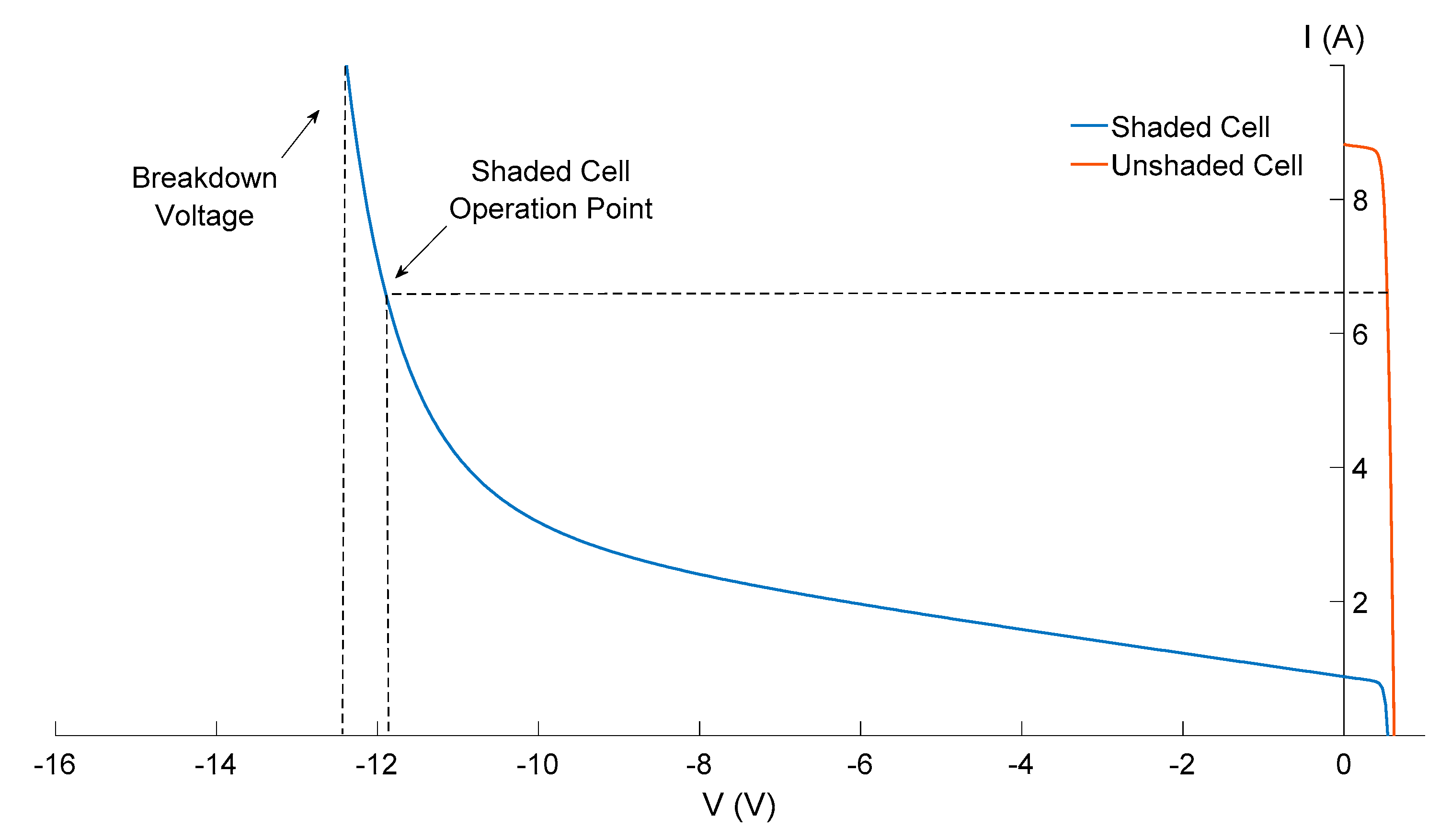
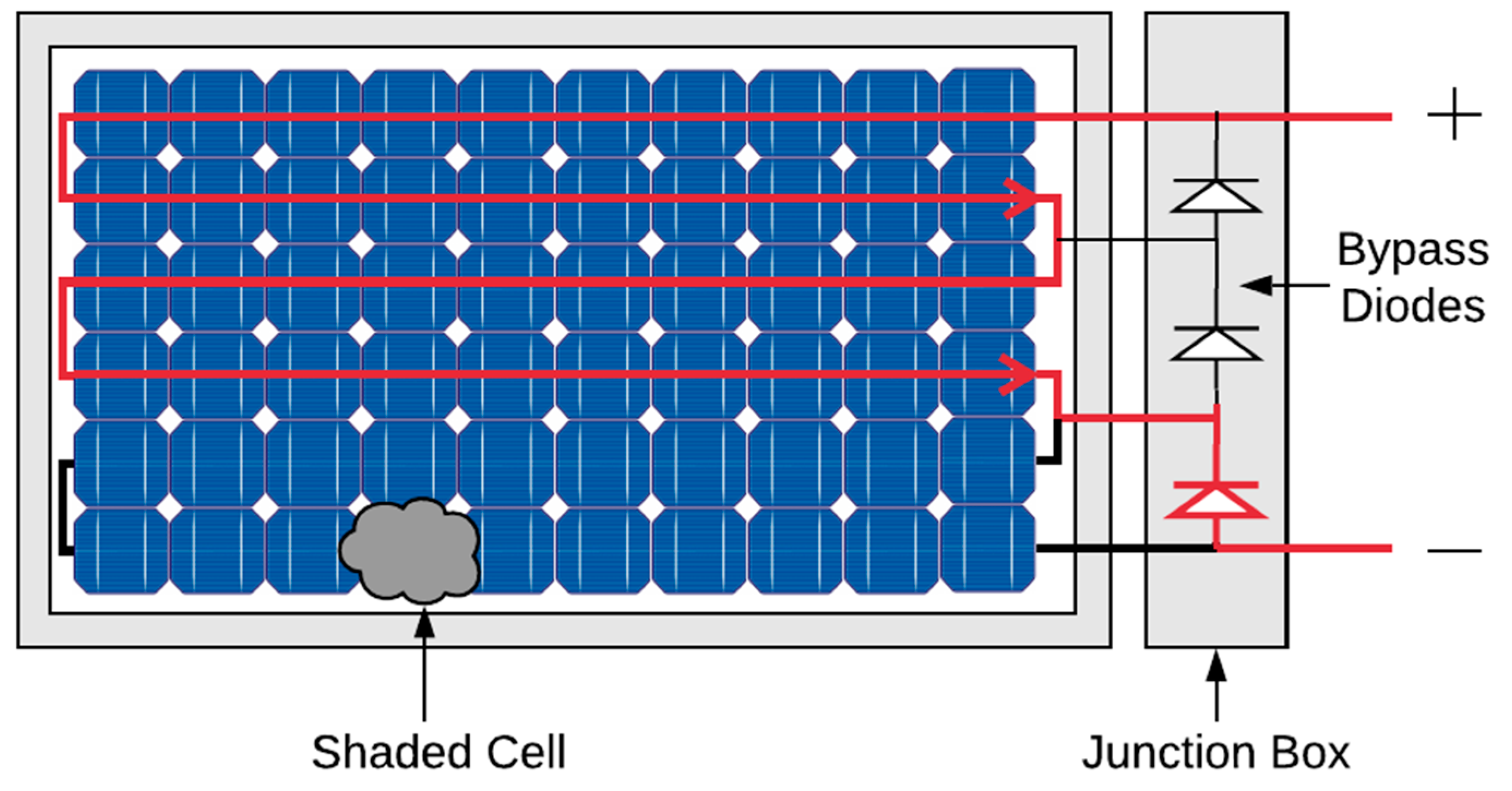

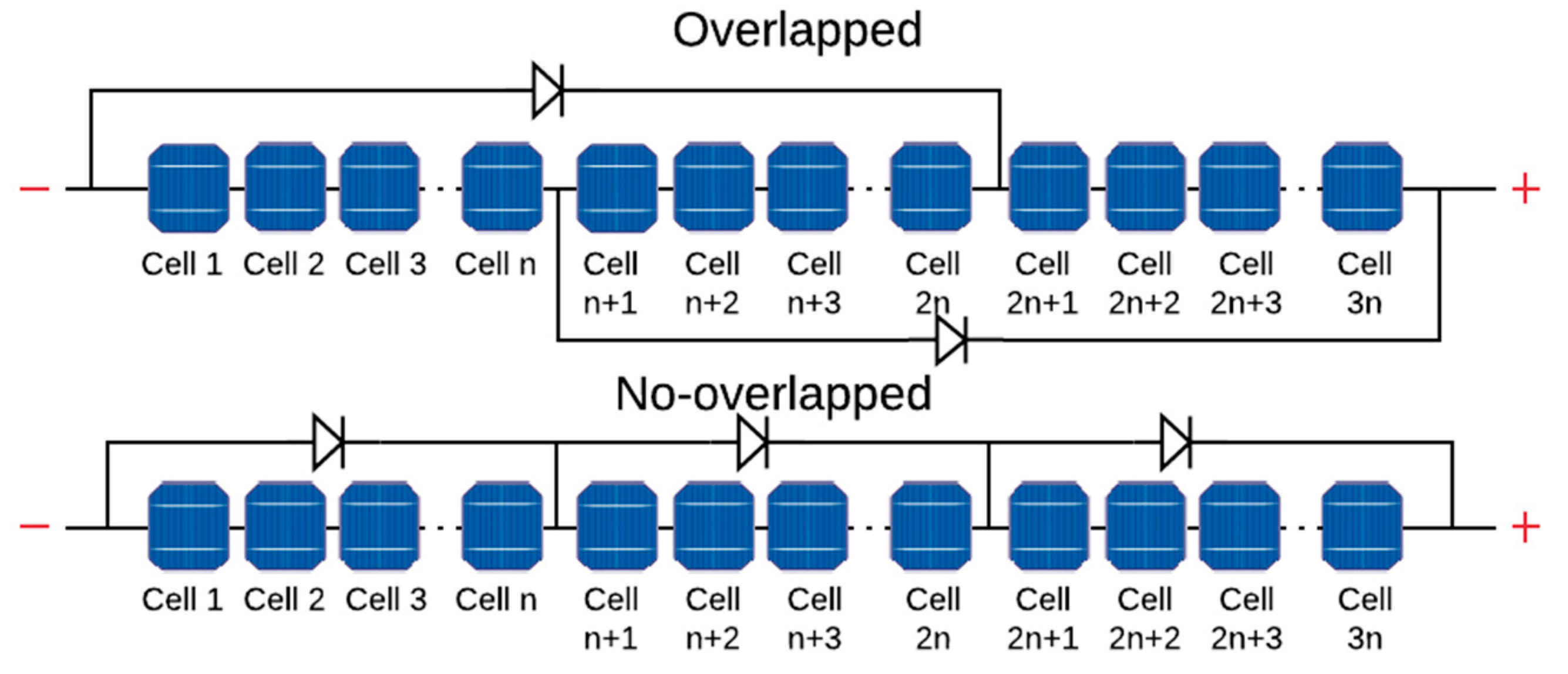
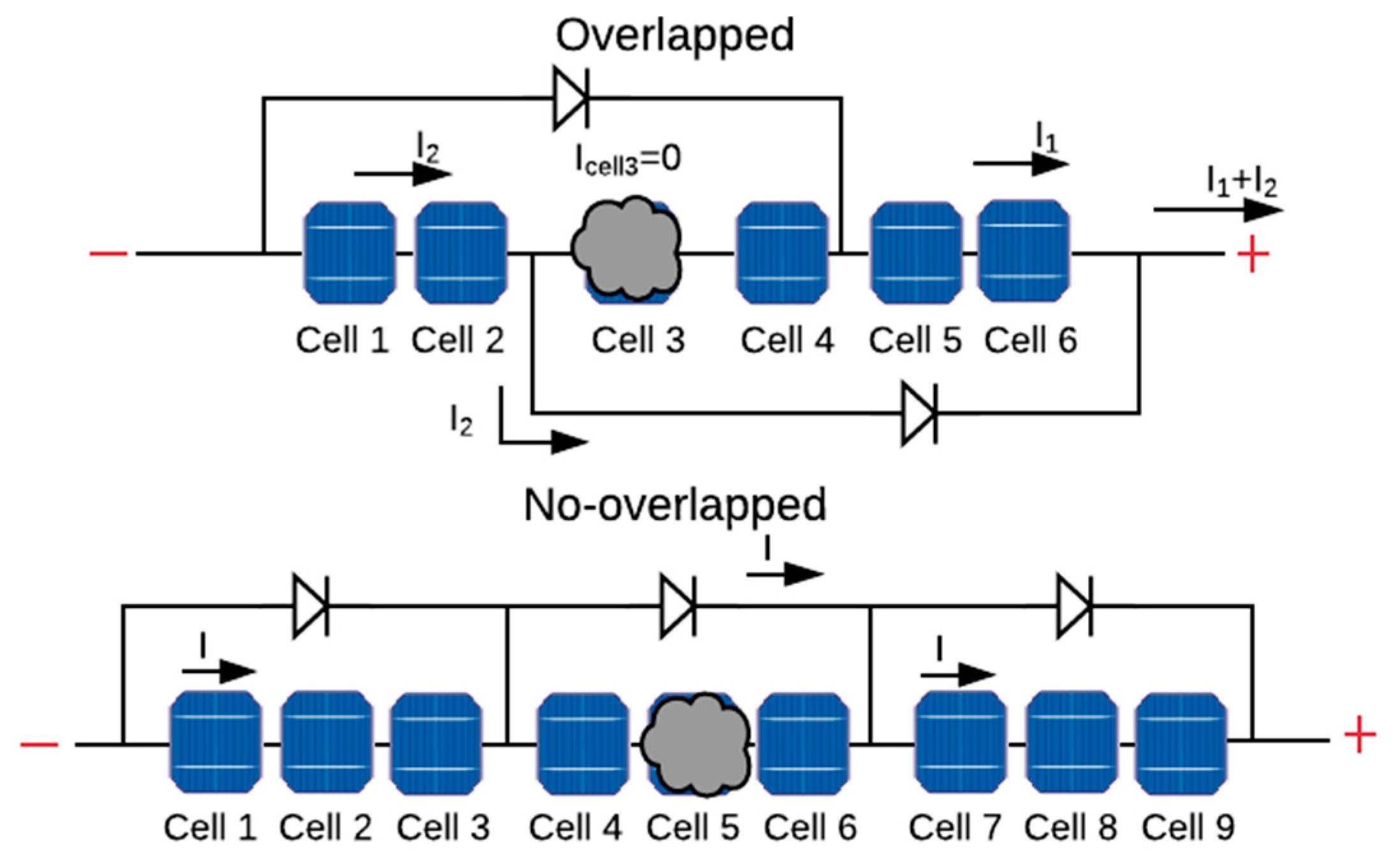

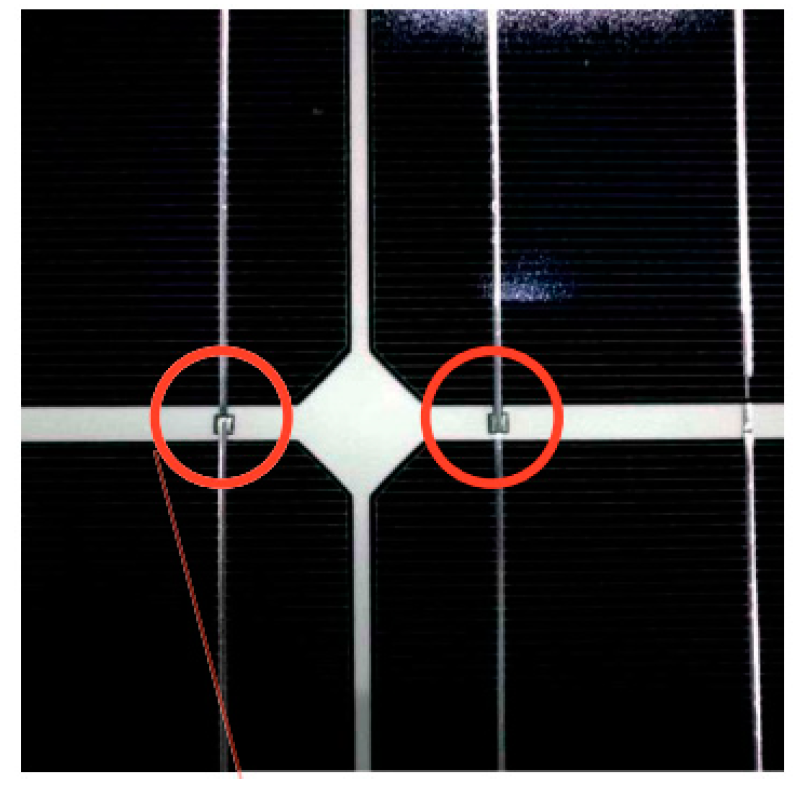

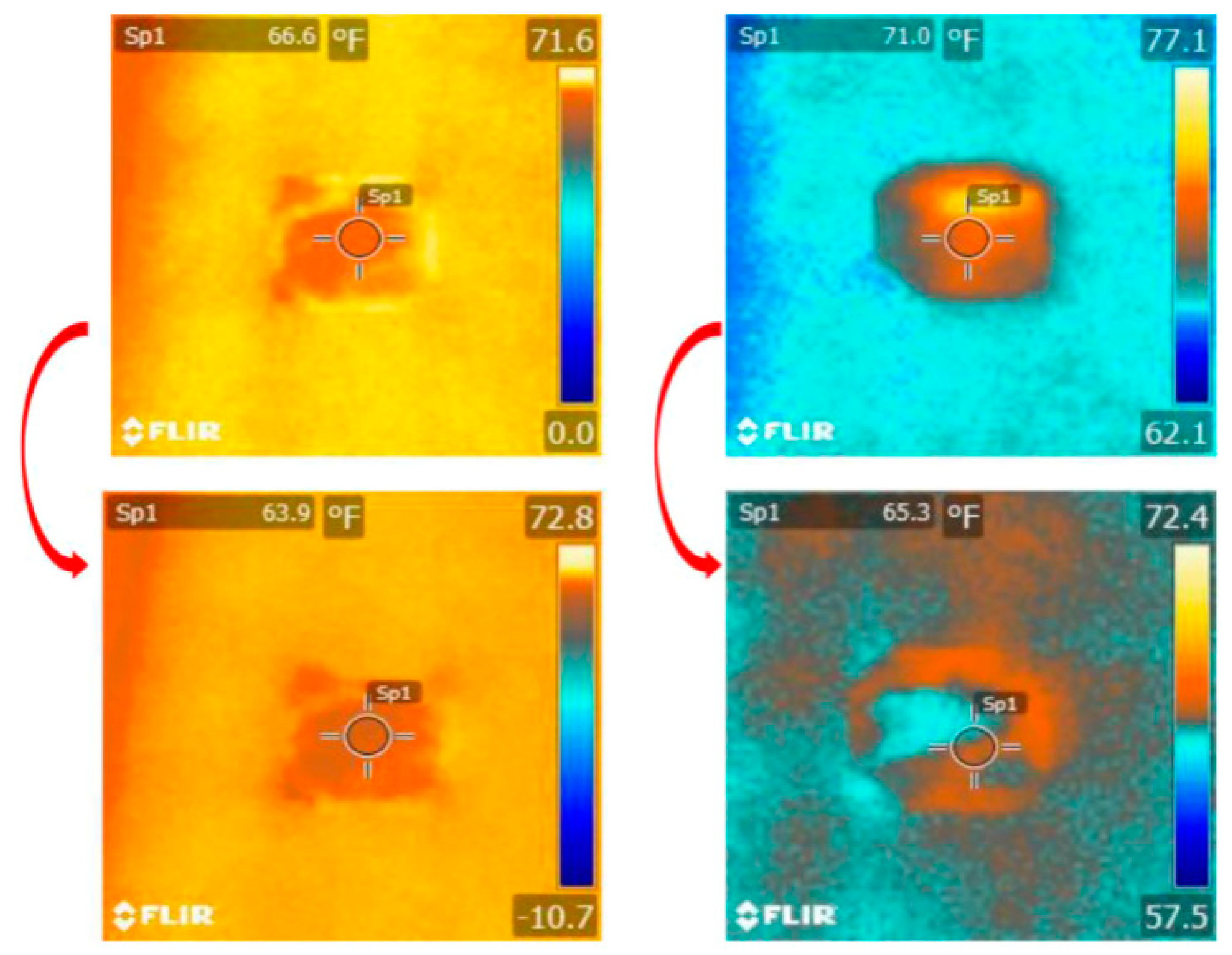

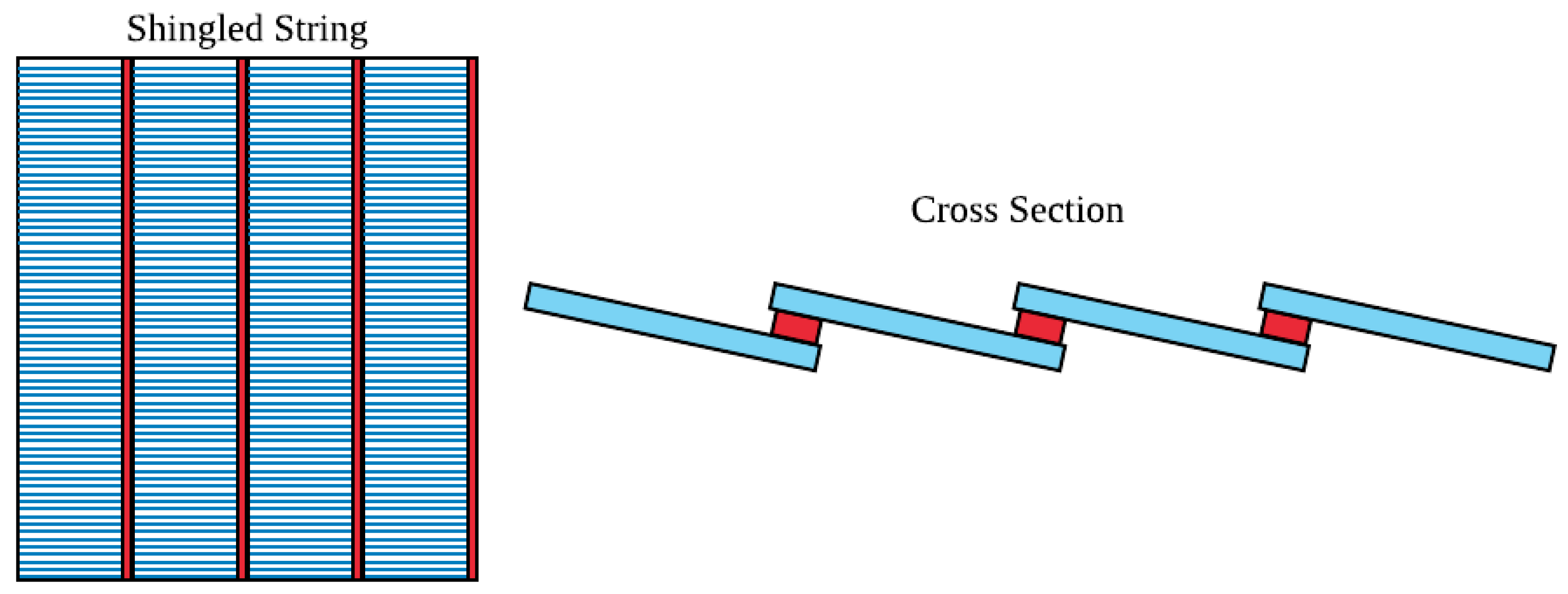
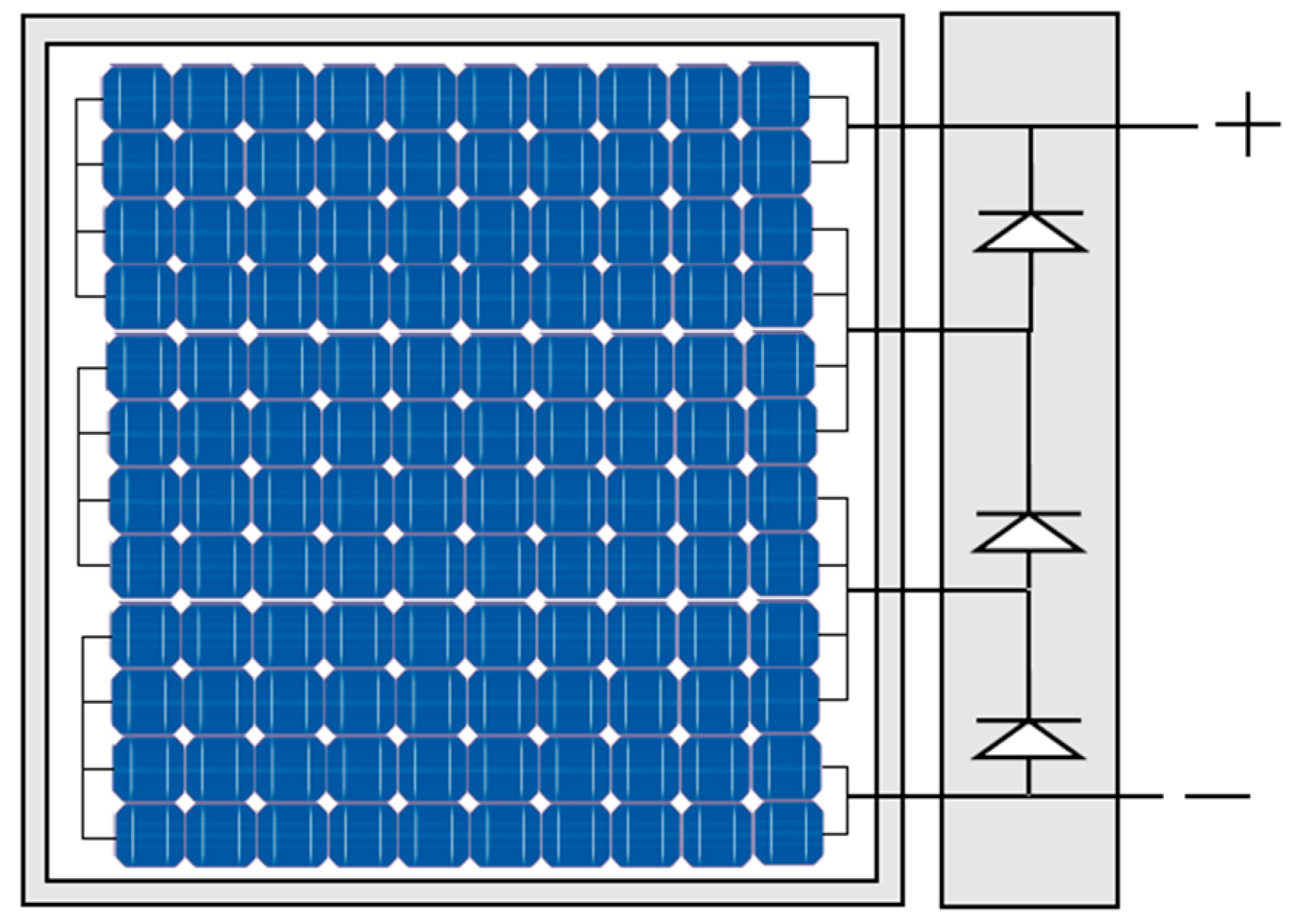
| Research Group | Purpose | Reference |
|---|---|---|
| Partial Shading | Estimate the shading effect to power output on PV modules using different connections of BP diode | [6,29,32,73,74,75,76,77,78,79,80,81,82,83,84,85] |
| Bypass Diode Topology | To investigate how different BP diodes arrangements within a PV module influences the voltage, current, and power characteristics | [5,8,17,19,31,86,87,88,89,90,91] |
| Filed Tests | Evaluate PV systems performance under real conditions | [27,92,93,94,95,96] |
| Artificial Intelligence | Applying artificial intelligence techniques for modelling and prediction of the performance of PV systems | [97,98,99,100,101,102,103,104,105,106,107,108] |
| New Mitigation Techniques | Search for new strategies to address the hotspot and shading problem | [7,18,109,110,111], [112] |
© 2020 by the authors. Licensee MDPI, Basel, Switzerland. This article is an open access article distributed under the terms and conditions of the Creative Commons Attribution (CC BY) license (http://creativecommons.org/licenses/by/4.0/).
Share and Cite
Vieira, R.G.; de Araújo, F.M.U.; Dhimish, M.; Guerra, M.I.S. A Comprehensive Review on Bypass Diode Application on Photovoltaic Modules. Energies 2020, 13, 2472. https://doi.org/10.3390/en13102472
Vieira RG, de Araújo FMU, Dhimish M, Guerra MIS. A Comprehensive Review on Bypass Diode Application on Photovoltaic Modules. Energies. 2020; 13(10):2472. https://doi.org/10.3390/en13102472
Chicago/Turabian StyleVieira, Romênia G., Fábio M. U. de Araújo, Mahmoud Dhimish, and Maria I. S. Guerra. 2020. "A Comprehensive Review on Bypass Diode Application on Photovoltaic Modules" Energies 13, no. 10: 2472. https://doi.org/10.3390/en13102472
APA StyleVieira, R. G., de Araújo, F. M. U., Dhimish, M., & Guerra, M. I. S. (2020). A Comprehensive Review on Bypass Diode Application on Photovoltaic Modules. Energies, 13(10), 2472. https://doi.org/10.3390/en13102472






